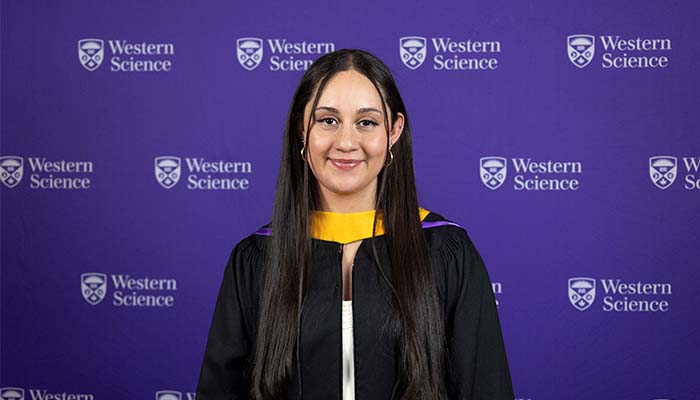Global Undergraduate Awards Spotlight: Gabriella Simonelli
The Global Undergraduate Awards recently announced the winning submissions for 2024, which include the following from Western: four Global Winners, four Regional Winners and 20 Highly Commended.

Gabriella Simonelli, BSc'24
Regional Winner: Life Sciences
Currently pursuing a Master of Management of Applied Science at Western
Paper title: The effects of post-mortem wing desiccation on vibrational patterns of field cricket wings
Please share a description of your research.
Essentially, what I'm doing is measuring wing vibrations of live and desiccated (which is like dead) cricket wings. In the past, what they did was used like museum specimens of extinct and rare species of crickets and measured the wing vibrations of the museum specimens to try to model what the cricket wings would have vibrated like when they were alive, so that they could reconstruct the calling songs of these crickets and classify them properly within their taxonomies. What hadn't been verified was whether those wings were going to be reliable replicates of what live wings would have been like. After removing the live wings from the body, I measured them over a period of two months and then I compared the wing vibrations to the desiccated wings. I also had sample specimens from another lab that were donated that were five years old. I compared the two, and what I found is that the shape of the vibrations between the live and the desiccated wings stays the same, but the resonant frequency, which is the key component of the calling song, does not. People that were using museum specimens to reconstruct the songs were getting proper shapes of the wing vibrations, but wrong resonant frequencies. What my research shows is that we have to find an alternative way to do those measurements so that they're more accurate. The second part of my project was re-hydrating the wings by putting them in water to see if they would recover any of their original properties. What I found was that the resonant frequencies returned to the live values, which tells us that if you put old specimens from the museum in water, you can get accurate vibration shapes and resonant frequencies for reconstructing songs a lot more accurately.
How did you become interested in this area?
I have always wanted to be a doctor. I can’t remember ever having another career aspiration. I’ve never had a backup plan. I think I was just immediately drawn to human body anatomy when I was younger and then I took a bunch of science courses through elementary school and high school, and I decided that those were my favourite classes, and what I wanted to focus on. When I was choosing a thesis, I chose a lab I wanted to work in, not necessarily a project. Then this project was suggested to me, and I learned so much along the way. I’m hoping to get back into the lab now that I’m back doing my master’s degree this year to work on something similar or an extension of this project.
Do you plan to continue in this area? What are your plans for the future?
Originally, I had planned to go to medical school but now I’m really enjoying the lab and research. I realized I have a little bit of a knack for research. For now, I’m still on the fence about whether I’ll pursue research long-term, but it’s definitely now an option to consider.
How did you feel when you found out you were selected as a winner?
It’s so nice to get recognition for something you’ve put so much work into. I’m excited to go to the Global Summit in Dublin and take part in the program that will have people from across the globe coming together to share our research and perspectives.

